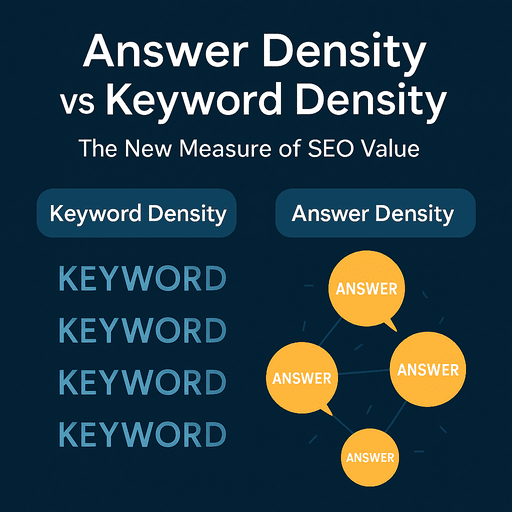Answer Density vs Keyword Density: The New Measure of SEO Value

Short Answer: Answer density measures how many unique, verifiable answers your content provides. Keyword density measures how many times a term repeats. In today’s SEO landscape, Google and AI search systems reward answer-rich pages that demonstrate clear, factual expertise, not repetitive phrasing.
1. What Is Keyword Density (and Why It’s Losing Power)
Keyword density once ruled SEO. It was the percentage of times your target term appeared compared to total word count. For years, writers optimized by numbers instead of meaning.
But modern algorithms no longer rely on surface repetition. In Does Keyword Density Still Matter for SEO in 2025? I explain how Google’s natural language models evaluate content based on topical depth and factual coverage, not mechanical keyword ratios.
Today, ranking comes from contextual completeness. You can use a keyword once if it appears in the right place, surrounded by relevant subtopics and structured answers that match user intent.
Example:
Instead of repeating “SEO best practices for small businesses,” focus on directly answering “How can small businesses optimize SEO on a tight budget?” One clear, verifiable answer beats five vague mentions.
2. What Is Answer Density (and Why It’s the Future of SEO)
Answer density means the number of distinct, verifiable answers a page provides for related queries within one topic cluster.
Search engines and AI Overviews now evaluate “fact units” rather than keyword repetition. Each unit represents a unique answer—a specific, testable statement that satisfies user intent.
Think of your content as a web of answers instead of a block of text. Each paragraph should teach something new, cite something credible, or clarify something users are already asking.
Why it matters:
-
AI Overviews extract high-quality answers to summarize results
-
Pages with multiple distinct answers gain multiple entry points for discovery
-
This builds both semantic trust and answer visibility
3. The Shift From Frequency to Factuality
The keyword era was about signals; the answer era is about substance.
AI-driven search tools like Google’s AI Overviews and Bing Copilot rely on answer graphs, networks of verified claims and entities, instead of keyword graphs. When your content offers multiple factual answers, each becomes a retrievable node in that graph.
If you understand how Google builds those relationships, it’s easier to see why factual precision beats keyword repetition. As I detail in How to Optimize for the Google Knowledge Graph, the Knowledge Graph connects your answers to verified entities such as people, places, products, and facts. That connection gives your content a stronger factual backbone, increasing its likelihood of being cited in AI-generated summaries.
To achieve this:
-
Write content that anticipates real-world questions
-
Group related questions into one cohesive topic cluster
-
Back each statement with a data point, study, or source
Your goal isn’t to repeat a phrase. It’s to expand the topic’s informational footprint.
4. How to Measure and Improve Answer Density
Step 1: Identify user questions using Google’s People Also Ask boxes, Reddit threads, or AI Overview queries.
Step 2: Write one short, clear answer for each.
Step 3: Support each with a citation, statistic, or credible reference.
Step 4: Audit your article for unique answers per 500–1,000 words.
Step 5: Cut repetition that doesn’t add new value.
5. Example: Keyword-Heavy vs Answer-Dense Paragraph
Keyword-Heavy:
“Answer density SEO is important because answer density SEO helps improve answer density SEO rankings.”
Answer-Dense:
“Answer density improves visibility because Google measures how many distinct, verifiable answers appear per page. Each unique answer increases your chance of being cited in AI Overviews.”
One offers nothing new. The other provides a clear, factual statement that can be extracted, verified, and reused by AI systems.
6. The Unified SEO Perspective: AEO, GEO, and OSO
Answer density sits at the heart of Unified SEO, where all visibility ecosystems—search engines, generative tools, and on-device assistants—overlap.
-
AEO (Answer Engine Optimization): Craft compact, factually correct answers to conversational questions
-
GEO (Generative Engine Optimization): Ensure your content provides factual segments that AI systems can summarize
-
OSO (Offline Search Optimization): Make those same answers indexable by local and on-device AI tools like Spotlight or Copilot
When your content is structured around verified answers instead of repeated phrases, it becomes universal—readable by humans, usable by AI, and discoverable across every surface.
Conclusion: The Era of Verifiable Value
Keyword density measured repetition.
Answer density measures trustworthiness, completeness, and clarity.
In the modern search ecosystem, ranking power doesn’t come from repeating a term—it comes from answering real questions better than anyone else.
If you want to audit your content for answer density and AI visibility, contact me for a Unified SEO analysis tailored to your brand’s factual footprint.

0 Comments Add a Comment?